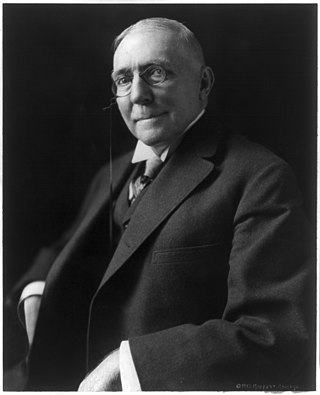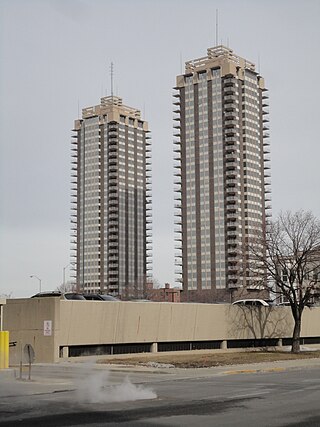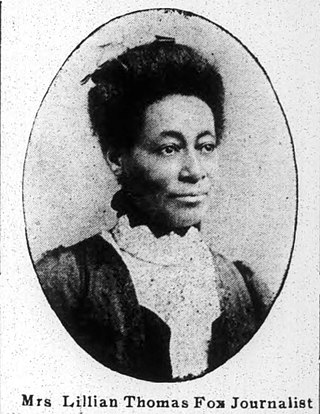
Marguerite Vivian Young was an American novelist and academic. She is best known for her novel Miss MacIntosh, My Darling. In her later years, she was known for teaching creative writing and as a mentor to young authors. "She was a respected literary figure as well as a cherished Greenwich Village eccentric." During her lifetime, Young wrote two books of poetry, two historical studies, one collection of short stories, one novel, and one collection of essays.

James Whitcomb Riley was an American writer, poet, and best-selling author. During his lifetime he was known as the "Hoosier Poet" and "Children's Poet" for his dialect works and his children's poetry. His poems tend to be humorous or sentimental. Of the approximately 1,000 poems Riley wrote, the majority are in dialect. His famous works include "Little Orphant Annie" and "The Raggedy Man".

James Whitcomb was a Democratic United States senator and the eighth governor of Indiana. As governor during the Mexican–American War, he oversaw the formation and deployment of the state's levies. He led the movement to replace the state constitution and played an important role at the convention to institute a law that prevented the government from taking loans in response the current fiscal crisis in Indiana. By skillfully guiding the state through its bankruptcy, Whitcomb is usually credited as being one of the most successful of Indiana's governors. He was elected to the United States Senate after his term as governor but died of kidney disease only three years later.

Indianapolis Public Schools (IPS) is the largest school district in Indianapolis, and the second largest school district in the state of Indiana as of 2021, behind Fort Wayne Community Schools. The district's headquarters are in the John Morton-Finney Center for Educational Services.
Seven neighborhoods in Indianapolis, Indiana, are designated as official Cultural Districts. These are Broad Ripple Village, Canal and White River State Park, Fountain Square, Indiana Avenue, Market East, Mass Ave, and the Wholesale District.

The Indianapolis Public Library (IndyPL), formerly known as the Indianapolis–Marion County Public Library, is the public library system serving the citizens of Marion County, Indiana, United States and its largest city, Indianapolis. The library was founded in 1873 and has grown to include its flagship Central Library and 24 branch libraries located throughout the county. In 2021, the public library system circulated 7.1 million items and hosted more than 2,500 programs for its 282,000 cardholders.

"Little Orphant Annie" is an 1885 poem written by James Whitcomb Riley and published by the Bobbs-Merrill Company. First titled "The Elf Child", the name was changed by Riley to "Little Orphant Allie" at its third printing; however, a typesetting error during printing renamed the poem to its current form. Known as the "Hoosier poet", Riley wrote the rhymes in 19th-century Hoosier dialect. As one of his most well known poems, it served as the inspiration for the comic strip Little Orphan Annie, which itself inspired a Broadway musical, several films, and many radio and television programs.

Broad Ripple Village is one of seven areas designated as cultural districts in Indianapolis, Indiana. Located in Washington Township, Marion County, Indiana, about six miles north of downtown Indianapolis, Broad Ripple was first platted in 1837, became incorporated as the Town of Broad Ripple in 1894, and was annexed to the City of Indianapolis in 1922.

Riley Towers are three residential high-rise apartment buildings in downtown Indianapolis, Indiana, United States. Riley Towers were conceived as part of an expansive urban renewal project known as Project H. The complex was constructed between 1962 and 1963. Towers I and II have 30 floors and Tower III has 16 floors. Riley Towers I and II are the tallest residential buildings in the state of Indiana. The towers are distinctive for their cantilevered corner balconies.
The Nina Mason Pulliam Indianapolis Special Collections Room is a special collection of the Indianapolis Public Library in Indianapolis, Indiana, United States.

Rose Elizabeth Fitzgerald Kennedy was an American philanthropist, socialite, and matriarch of the Kennedy family. She was deeply embedded in the "lace curtain" Irish-American community in Boston. Her father, John F. Fitzgerald, served in the Massachusetts State Senate (1892–1894), in the U.S. House of Representatives, and as Mayor of Boston. Her husband, Joseph P. Kennedy Sr., chaired the U.S. Securities and Exchange Commission (1934–1935) and the U.S. Maritime Commission (1937–1938), and served as United States Ambassador to the United Kingdom (1938–1940). Their nine children included United States President John F. Kennedy, U.S. Senator Robert F. Kennedy of New York, U.S. Senator Ted Kennedy of Massachusetts, Special Olympics founder Eunice Kennedy Shriver, and U.S. Ambassador to Ireland Jean Kennedy Smith. In 1951, Rose Kennedy was ennobled by Pope Pius XII, becoming the sixth American woman to be granted the rank of Papal countess.
Dan Wakefield was an American novelist, journalist, and screenwriter.

The Indianapolis Art Center is an art center located in Indianapolis, Indiana, United States. The center, founded in 1934 by the Works Project Administration during the Great Depression as the Indianapolis Art League, is located along the White River. It features fine art exhibitions, art classes and studios, a library with over 5,000 titles, and the ARTSPARK nature and art parks. As of 2008 the Indianapolis Art Center featured over 50 annual exhibitions and had over 3,000 members.

Little Orphant Annie is a 1918 American silent drama film directed by Colin Campbell and stars Colleen Moore, in her first leading role, as the title character. The film is based on James Whitcomb Riley's popular 1885 poem of the same title. Riley also appears in the film.

Lillian May Parker Thomas Fox was an African American journalist, clubwoman, public speaker, and civic activist in Indianapolis, Indiana, who rose to prominence in the 1880s and 1890s as a writer for the Indianapolis Freeman, a leading national black newspaper. In 1900, Fox joined the Indianapolis News, becoming the first African American columnist to regularly write for a white newspaper in Indiana. She was inducted into the Indiana Journalism Hall of Fame in 2014.

Lillian A. Lewis was the first African American woman journalist in Boston, Massachusetts. She started her career in the 1880s with the Boston Advocate, a Black community newspaper, and began writing for the Boston Herald in the 1890s. To disguise her gender, she used the pen name "Bert Islew."
The Western Association of Writers was an American writers' organization founded in Indiana. It enrolled among its members men and women who were early or seasoned in their careers.

Pompeiiana, Inc. was a 501c3 not-for-profit corporation dedicated to the study of Latin at the secondary school level. It was founded by Bernard F. Barcio, L.H.D. and was run by a board of directors, which included Allen W. Clowes, Carl R. Dortch (treasurer), Mrs. Lillian R. Barcio (secretary), and Philip S. Kappes It was known for sponsoring and coordinating "such nation-wide Latin-oriented multi-discipline projects as the National Catapult Contest,", the National Chariathon, and for publishing the Pompeiiana Newsletter.















